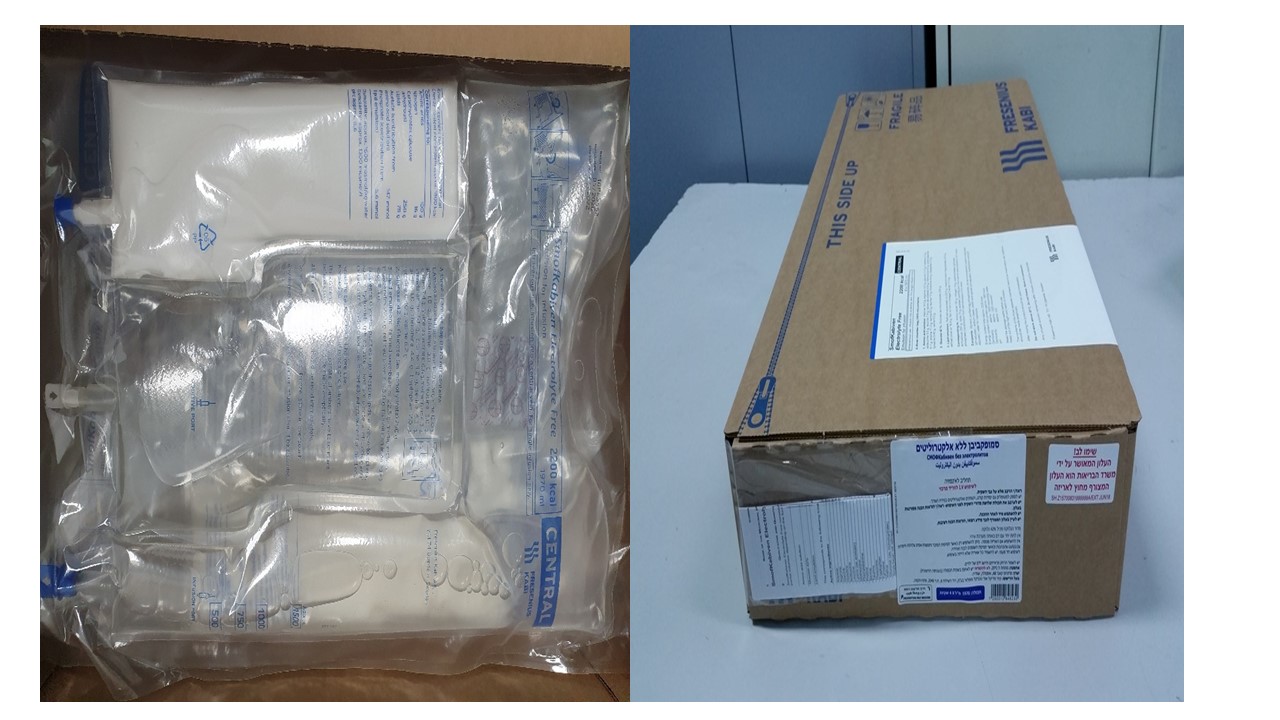Quest for the right Drug

סמופקביבן ללא אלקטרוליטים SMOFKABIVEN ELECTROLYTE FREE (AMINOACETIC ACID, FISH OIL, GLUCOSE MONOHYDRATE, L- ALANINE, L- ISOLEUCINE, L- LEUCINE, L- LYSINE ACETATE, L- METHIONINE, L- PHENYLALANINE, L- PROLINE, L- THREONINE, L- TRYPTOPHAN, L- TYROSINE, L- VALINE, L-ARGININE, L-HISTIDINE, L-SERINE, OLIVE OIL, SOYA OIL, TAURINE, TRIGLYCERIDES, MEDIUM-CHAIN)
תרופה במרשם
תרופה בסל
נרקוטיקה
ציטוטוקסיקה
צורת מתן:
תוך-ורידי : I.V
צורת מינון:
תחליב לאינפוזיה : EMULSION FOR INFUSION
עלון לרופא
מינוניםPosology התוויות
Indications תופעות לוואי
Adverse reactions התוויות נגד
Contraindications אינטראקציות
Interactions מינון יתר
Overdose הריון/הנקה
Pregnancy & Lactation אוכלוסיות מיוחדות
Special populations תכונות פרמקולוגיות
Pharmacological properties מידע רוקחי
Pharmaceutical particulars אזהרת שימוש
Special Warning עלון לרופא
Physicians Leaflet
Special Warning : אזהרת שימוש
4.4 Special warnings and precautions for use The capacity to eliminate lipids is individual and should therefore be monitored according to the routines of the clinician. This is in general done by checking the triglyceride levels. The concentration of triglycerides in serum should not exceed 4 mmol/l during infusion. An overdose may lead to fat overload syndrome, see section 4.8. SmofKabiven Electrolyte Free should be given with caution in conditions of impaired lipid metabolism, which may occur in patients with renal failure, diabetes mellitus, pancreatitis, impaired liver function, hypothyroidism and sepsis. This medicinal product contains soya-bean oil, fish oil and egg phospholipids, which may rarely cause allergic reactions. Cross allergic reaction has been observed between soya-bean and peanut To avoid risks associated with too rapid infusion rates, it is recommended to use a continuous and well-controlled infusion, if possible by using a volumetric pump. Since an increased risk of infection is associated with the use of any central vein, strict aseptic precautions should be taken to avoid any contamination during catheter insertion and manipulation. Serum glucose, electrolytes and osmolarity as well as fluid balance, acid-base status and liver enzyme tests should be monitored. Blood cell count and coagulation should be monitored when lipids are given for a longer period. SmofKabiven Electrolyte Free is produced almost electrolyte free for patients with special and/or limited electrolyte requirements. Sodium, potassium, calcium, magnesium and additional amounts of phosphate should be added governed by the clinical condition of the patient and by frequent monitoring of serum levels. In patients with renal insufficiency, the phosphate intake should be carefully controlled to prevent hyperphosphatemia. The amount of individual electrolytes to be added is governed by the clinical condition of the patient and by frequent monitoring of serum levels. Parenteral nutrition should be given with caution in lactic acidosis, insufficient cellular oxygen supply and increased serum osmolarity. Any sign or symptom of anaphylactic reaction (such as fever, shivering, rash or dyspnoea) should lead to immediate interruption of the infusion. The lipid content of SmofKabiven Electrolyte Free may interfere with certain laboratory measurements (e.g. bilirubin, lactate dehydrogenase, oxygen saturation, hemoglobin) if blood is sampled before lipids have been adequately cleared from the bloodstream. Lipids are cleared after a lipid-free interval of 5-6 hours in most patients. Intravenous infusion of amino acids is accompanied by increased urinary excretion of the trace elements, in particular copper and zinc. This should be considered in the dosing of trace elements, especially during long-term intravenous nutrition. In malnourished patients, initiation of parenteral nutrition can precipitate fluid shifts resulting in pulmonary oedema and congestive heart failure as well as a decrease in the serum concentration of potassium, phosphorus, magnesium and water soluble vitamins. These changes can occur within 24 to 48 hours, therefore careful and slow initiation of parenteral nutrition is recommended in this patient group, together with close monitoring and appropriate adjustments of fluid, electrolytes, minerals and vitamins. SmofKabiven Electrolyte Free should not be given simultaneously with blood in the same infusion set due to the risk of pseudoagglutination. In patients with hyperglycaemia, administration of exogenous insulin might be necessary. Paediatric population Due to composition of the amino acid solution in SmofKabiven Electrolyte Free it is not suitable for the use in newborns or infants below 2 years of age. There is no clinical experience of the use of SmofKabiven Electrolyte Free in children (age 2 to 16/18 years).
Effects on Driving
4.7 Effects on ability to drive and use machines Not relevant.

שימוש לפי פנקס קופ''ח כללית 1994
לא צוין
תאריך הכללה מקורי בסל
לא צוין
הגבלות
לא צוין
מידע נוסף
עלון מידע לרופא
03.12.20 - עלון לרופאעלון מידע לצרכן
03.12.20 - החמרה לעלוןלתרופה במאגר משרד הבריאות
סמופקביבן ללא אלקטרוליטים